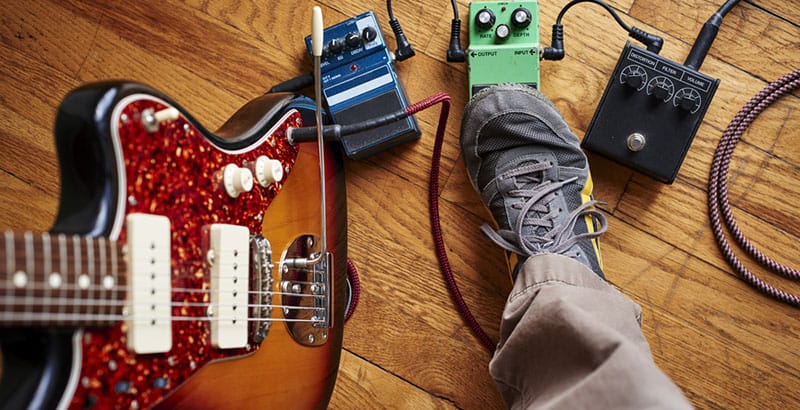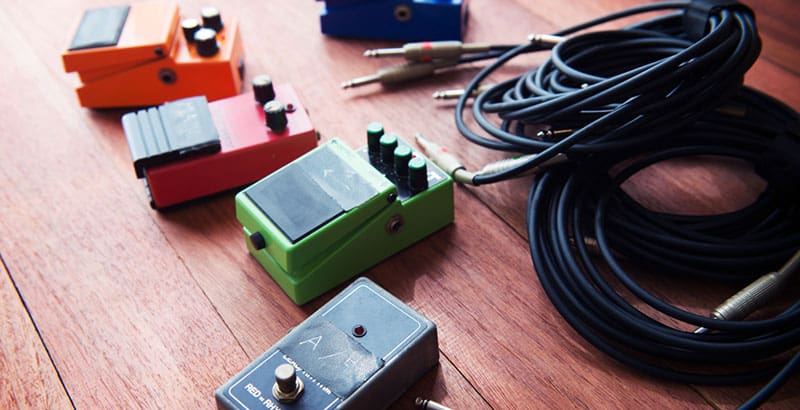
Every guitarist wants to sound like a professional musician, whether in their living room or on stage, and guitar pedals are a vital tool that makes that dream a reality. Guitar pedals have played a fundamental role in defining many iconic sounds we associate with modern-day music and have helped pioneer genres like rock and blues.
Guitarists use pedals to enhance, control, or manipulate their guitar's sound for at-home and live performances. The type of pedal a guitarist uses depends on whether they aim to distort or modulate sounds or alter their music's dynamics and timing.
These days, the list for guitar pedal options seems to be never-ending. Read on to dive deeper into the world of effect pedals and why they are necessary for every amateur and professional electric guitarist’s studio.
Table of Contents
Why Do Guitarists Use Pedals?
Whether a guitarist is looking to add some extra power to their power chords with overdrive, create elegance and ambiance in melodies with reverb, or become their own one-man-band with the help of a loop pedal, effect pedals are an incredible tool that can give a guitarist the cutting edge and creative inspiration they strive for as a musician.
The reasons a guitarist keeps a pedal plugged into their amp varies from player to player, but generally, all musicians will admit that guitar pedals offer the following benefits:
Ease of Use
For the most part, guitar pedals are very easy to use. For example, the classic “stomp box” style guitar pedals are plug-in and play, with the effect being controlled by the movement of the guitarist’s foot on the pedal.
Mastering some pedals will require some practice and patience, but the overall concept is not rocket science.
However, there are guitar pedals out there, such as multi-effect pedals. These pedals will often require a technical approach, with more capabilities such as tweaking the pedal’s effects to the guitarist’s liking.
Pedals Are Practical
Guitar amplifiers can, in many ways, do the same thing that an effect pedal does, but it is not always a fun experience lugging a heavy amp around every time you want to jam with your friends or even play a gig.
With many pedals small enough to fit into your pocket and most others that easily fit into a backpack, they can take some of the labor out of a guitarist’s life.
Not every guitarist has the luxury of having more than one amp to give variety to their sound. Still, the ability to build a small collection of pedals is within reach of even the most amateur and casual guitarists.
Note: Keep in mind that you will need to have an amp to plug your pedal into, which will require a bit of lugging, depending on the type of amp available.
Pedals Have Different Effects
The great thing about guitar pedals is they don’t just create one sound—each effect is different. They can enhance the character of a guitar’s sound or change its entire dynamic.
Types of Pedal Effects
Here are some classic pedal effects that have shaped music as we know it:
- Distortion: In small doses, distortion can add warmth and character to your guitar, or if put to extreme settings, it can become very aggressive and loud enough to have an angry neighbor knocking at your door.
- Delay: Delay alters the timing of every pluck and strum made, resulting in a delightful echo effect.
- Reverb: Reverb emulates a space your music is playing in, which can range from sounding like the guitar is in a closet or a large cathedral, creating a blissful ambiance.
- Phaser: This exciting effect emits a sweeping, sonic motion, which many of us experience when listening to classic rock from the ’60s and ’70s.
- Wah: The Wah pedal speaks for itself, as its name accurately describes what you will hear. When used properly, this creates an incredibly powerful effect. When abused or mismanaged, you will likely make your audience cringe.
- Flanger: This produces an effect like the Phaser, which hits your ears with a sweeping like motion but has a bit more grit in its movement—a classic in the world of hard rock.
- Fuzz: Rock music would not be the same without this pedal, as its fuzzy, warm distortion is recognized across the board in the genre.
While these are classic pedals guitarists have used for decades in their parents’ garages or on the main stages of legendary performances, musicians have a much wider selection than they once did, as the innovation in guitar pedals has not stopped growing in the years since these machines were first popularized.
With multi-effect pedals on the scene, the ability to let your creativity run wild is as easy as learning a few chords and letting the pedal do the rest, with features such as layering multiple effects together and fine-tuning effect parameters.
Pedals Give Guitarists and Their Music Personality
It’s incredible to think that a device the size of an average smartphone has the power to take your guitar’s sound to a whole new dimension.
When a guitarist sits down to jam, their mission is to create something unique—a pedal is a tool that can make their guitar sound bend, scream, and shine. Having as little as a single pedal may be the key element of a guitarist’s unique style and the factor that makes them stand out as a musician—especially after putting in the time to practice.
Pedals Allow More Creativity
Additionally, for many guitarists, a pedal is the very thing that brings out their creativity. Imagine a guitar as a paintbrush and every pedal a new color to add to the canvas.
After playing and practicing on the same guitar with the same amp, the prospect of hearing something that sparks the imagination can become more and more challenging. Plugging in a new pedal may just be the tool a guitarist is missing from their creative flow—hearing sounds that are new to the ear is as fun as it is exciting.

Choosing the Right Pedal to Maximize Benefits
With so many options to choose from, it can feel intimidating to pick out the pedal that’s right for you—especially if you are jamming on a budget.
Luckily, guitarists don’t need to break the bank when making this choice. Various pedals are marked at very reasonable prices for electric, bass, and amplified acoustic guitars, putting the cost within reach of even a high schooler’s allowance. If cost is not a significant factor, there are many pedals with incredible capabilities on the high-end, too.
Here are some well-rounded options to consider:
| $18-$40 | $40-$120 | $220-$450 |
| Lotmusic DC 9V (Crunch Distortion) | Zoom G1X FOUR Guitar Multi-Effects Processor | Line 6 POD Go Guitar Multi-Effects Pedal |
| AZOR Classical Overdrive Effect Pedal AP-308 | Zoom MS-50G MultiStomp Guitar Effects Pedal | Zoom G5n Guitar Multi-Effects Processor |
| Donner Yellow Pure Analog Delay Effect Pedal | NUX MG-100 Multi-Effects Pedal | Zoom G3Xn Guitar Multi-Effects Processor |
Some brands certainly stand out in the guitar pedal industry and are worthy of consideration when committing to a purchase:
- Zoom
- Boss
- Digitech
- Ibanez
- Death by Audio
- Strymon
While many big-name brands come with a certain guarantee of quality and reliability, there are countless options worthy of looking into. In fact, thinking outside the box and giving a new guitar pedal brand a chance may be a determining factor in a guitarist’s discovery of new sounds and individualistic style.
Why Do Guitarists Use Pedals? Final Thoughts
Since guitar pedals arrived in the music world, they have shaped the sounds we hear and have significantly boosted guitarists' creativity around the world-delivering sounds that have shattered the barriers of guitarist’s writers’ block and electrified our lives in the process.
Their practicality and ease of use have made them an industry-standard in many music genres—rock and roll would not be what it is today if not for guitar pedals.
Can a guitarist play the guitar without a pedal? Yes. But the potential and power of an effect pedal are why most professional and amateur guitar players have at least one in their studio.
Side note, do you want to learn to play guitar songs the easy way? Learn how here – results are guaranteed!